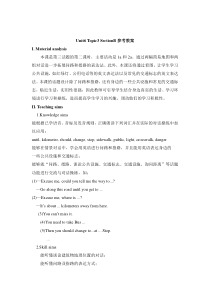 DOC
DOC
【文档说明】Unit 6 Topic 3《How can I get to the library》(SectionB)word教案-七年级下册英语【仁爱版】.doc,共(8)页,45.000 KB,由小喜鸽上传
转载请保留链接:https://www.ichengzhen.cn/view-104123.html
以下为本文档部分文字说明:
Unit6Topic3SectionB参考教案I.Materialanalysis本课是第三话题的第二课时,主要活动是1a和2a。通过两幅简易地图和两组对话进一步拓展问路和指路的表达法。此外,本课还将通过看图,让学生学习公共设施,如红绿灯、公用电话等的英文表达法以及常见的交通标志的英
文表达法。本课的话题设计除了问路和指路,还有身边的一些公共设施和常见的交通标志,贴近生活,实用性很强,因此教师可引导学生结合身边真实的生活、学习环境进行学习和操练,进而提高学生学习的兴趣,调动他们的学习积极性。II.Teachingaims1.Knowledgeaims能根据已学语音、音
标及发音规则,正确朗读下列词汇并在实际的对话操练中加以应用:until,kilometer,should,change,stop,sidewalk,public,light,crosswalk,danger能够在情景对话中,学会用英语进行
问路和指路,并且能用英语表达身边的一些公共设施和交通标志;能够就“问路、指路、谈论公共设施、交通标志、交通设施、询问距离”等话题功能进行交流与对话操练,如:(1)—Excuseme,couldyoutellmethewayto...?—Go
alongthisroaduntilyougetto...(2)—Excuseme,whereis...?—It’sabout...kilometersawayfromhere.(3)Youcan’tmis
sit.(4)YouneedtotakeBus...(5)Thenyoushouldchangeto...at...Stop....2.Skillaims能听懂谈论建筑物地理位置的对话;能听懂问路及指路的表达方式;能使用英语进行问路及指路;能在口头
表达中做到发音清晰,语音语调准确;能正确朗读对话,注意语音语调;能读懂简单的英文地图;能读懂简单的交通标志和交通规则;能使用所学表达法进行对话写作,描述到达某建筑物的路线。3.Emotionalaims认识
交通标志、学习交通规则,同时增强交通安全意识,珍爱生命;能够与同伴积极合作,参与课堂活动,大胆实践;能够在课堂活动中培养乐于助人的观念。III.Thekeypointsanddifficultpoints能够在情景对
话中,就“问路、指路”等话题功能用英语来表达方向以及建筑物的地理位置,同时能够在对话中谈论公共设施和常见的交通标志。IV.Learningstrategies1.能够养成运用图片、关键词等帮助听说的学习策略;2.能够清楚、大声地进行朗读,认真听录音和老师的发音
,大胆开口,反复模仿;3.能在学习过程中养成结合实际学习英语的好习惯。V.Teachingaids录音机、教学挂图、闪卡和黑板VI.TeachingproceduresStepInteractionpatternStudentac
tivityTeacheractivityIntroduction(5minutes)1.Thewholeclasswork.2.Pairwork.1.Focusyourattentionontheteacher.2.
Dodutyreport.Drawyourownmaptodescribehowtogettotheschoolfromyourhome.Makeupanew1.Getstudentsreadyforlearning.2.Helpthestudent
srevisethewordsandexpressionsinthelasttopic.3.Individualwork.conversationinpairs.Thenpracticetheconversation.Somepairsshowyourm
apsandactouttheconversationstothewholeclass.e.g.A:Maria,howcanyougettoyourschool?B:Well,IliveonGuangqianRoad.GoupGuangqianRoad
andturnleftatthesecondcrossing.It’sonWestStreet.GodownWestStreettotheend.Theschoolwillbeonmyright.Andyou?A:......3.Lookatthepictureof1ainSectionA.
Listentotheteacher’squestionsaboutaskingways.Trytoanswertheteacher’squestionsasquicklyasyoucan.T:SupposeIaminAplace.Nowhowc
anIget3.Helpthestudentsrevisetheexpressionsaboutaskingwaysandgivingdirections.tothelibrary?S1:GoalongXinhuaStreetandt
urnrightatthefirstcrossing.It’sabouttwentymetersalongontheleft.T:Good.Now,whichisthewaytothehospital?S2:...T:Couldy
outellmethewayto.../Whereis...(Leadtothenewexpressionsaboutaskingwaysinconversation.)S3:Goalong...untilyougetto...Turnleftandwalkon.Prese
ntation(10minutes)1.Individualworkandpairwork.1.Lookatthepicturesin1a.Answerthefollowingquestions:(1)HowcanyougettoDinghaoBuilding?(2)Atwhichb
usstopcanyouchangetotheNo.108bus?Listentothetapeandcheckyouranswers.Readthephrasesin1b.Guesstheanswersinthe1.Makethestudentslearntousethepicturesa
nddiagramstohelpthemlisten.Playthetaperecorderandchecktheanswers.2.Individualworkandpairwork.blanks.Thenlistenagainandwritedownthekeywordsorphrasesi
n1b.Listentothetapethethirdtimeandchecktheanswerswithyourpartner.2.Do1c.Read1aagain.Underlinethesentencesin1aaboutaskingwaysandgivingdirections.
Checkwithyourpartner.2.Makethestudentsfindthefunctionalsentencesbythemselves.Consolidation(10minutes)1.Thew
holeclassworkandpairwork.1.Read1aafterthetape.Practicetheconversationinpairsbasedon1b.Somepairsactouttheconversa
tiontothewholeclass.1.Playthetaperecorder.Tobeagoodlistener.Practice(10minutes)1.Individualwork,pairworkandthewholecl
asswork.1.Do2a.Lookatthepicturesin2a.Completetheconversationsindividuallybeforelistening.Thenlistentothetapeandcheckyouranswers.Afterthat,checky
ouranswerswithyourpartner.Listenagainandreadafterthetape.Thewholeclasscheck1.Playthetaperecorder.Checktheanswers.Tobeagoo
dlistener.2.Thewholeclasswork.3.Groupworkandindividualwork.theanswers.Practicetheconversationsinpairs.2.Do2b.Lookatthepicturesin2
baboutthepublicfacilities.Learnsomenewwords,public,light,sidewalk,crosswalk.Dobrainstorming.Trytosaythewordsaboutpublicfacilitiesasmanyasyouc
an.Lookatthepicturesonthescreen.Trytosaythewordsasquicklyasyoucan.3.Sitingroups.Discusswithyourgroupmembe
rsaboutthetrafficsignsaroundyouinyourreallife.Drawthemdown.Thensomegroupsshowyourpicturestothewholeclassandteachthewor
dsoftrafficsignstothewholeclass.Thendo3.Lookateachsignin3andmatchit2.Showpictures.Presentandpracticen
ewwords.3.Helpthestudentslearnsomewordsabouttrafficsignswiththehelpofthepicturesbythemselves.withitsmeaningindividually.Checktheanswerswi
thyourgroupmembers.Discussingroupsaboutthedifferencesbetweentheeasterntrafficsignsandwesterntrafficsigns.Product
ion(10minutes)1.Pairwork.1.Sitinpairs.Lookatthemapgivenbytheteacheronthescreen.Makeupnewconversationsaboutaskingwaysandgivingdirect
ionsinpairs.Practicethem.Thensomepairsactoutyourconversationstothewholeclass.A:Excuseme,whereisthebank?B:GoalongZh
ongshanRoaduntilyougettotheend.Turnright.It’sonyourleft.Youcan’tmissit.A:Thanksalot.B:You’rewelcome....1.Makethestudentslea
rntousewhattheyhavelearnedinrealsituation.2.Assignthehomework:ReviewthewordsandpracticetheconversationsinSectionAwithyourpartner;Goonma
kingconversationsabouthowtoaskingwaysandgivingdirectionsinpairs.Thenreportittotheclassnextday;PreviewSectionB;Collectmoret
rafficsignsinyourlife.Teachingreflection:在本课中,学生在听力活动与两两对话中,学习并操练了关于“问路”和“指路”的表达方式。“问路”和“指路”是我们生活中常见的话题,但是有的学生方向感不强
,尤其在平面地图中经常会迷失方向,因此,教师可引导学生结合身边真实的生活环境来操练“问路”和“指路”的对话,这样一来,学生就能比较直观、有效地学习并掌握这两个话题功能的用法。同样地,本课学习了交通标志以及身边一些公共设施的英语表达
,教师可引导学生在课外多在身边发现类似的标志,并尝试用英语表达。VII.BlackboarddesignTopic3Whichisthewaytothehospital?SectionB1.Couldyoutellmethewayto...?until2.Go
along...untilyougetto...kilometer3.Turnleftandwalkon.should4.Youcan’tmissit.change5.Whereis...?stop6.Youshouldch
angetotheNo.108bus…sidewalkpubliclightcrosswalkdanger
 辽公网安备 21102102000191号
辽公网安备 21102102000191号
 营业执照
营业执照